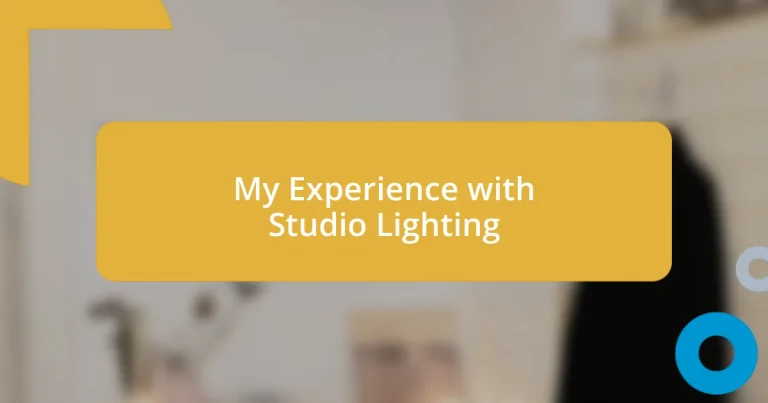Key takeaways:
- Understanding the distinction between hard and soft light is crucial for achieving different moods and effects in photography.
- Experimenting with lighting setups and equipment, such as softboxes and strobes, can dramatically impact the quality and character of your images.
- Adjusting lighting based on the subject’s requirements and environment enhances the overall aesthetic and storytelling in photography.
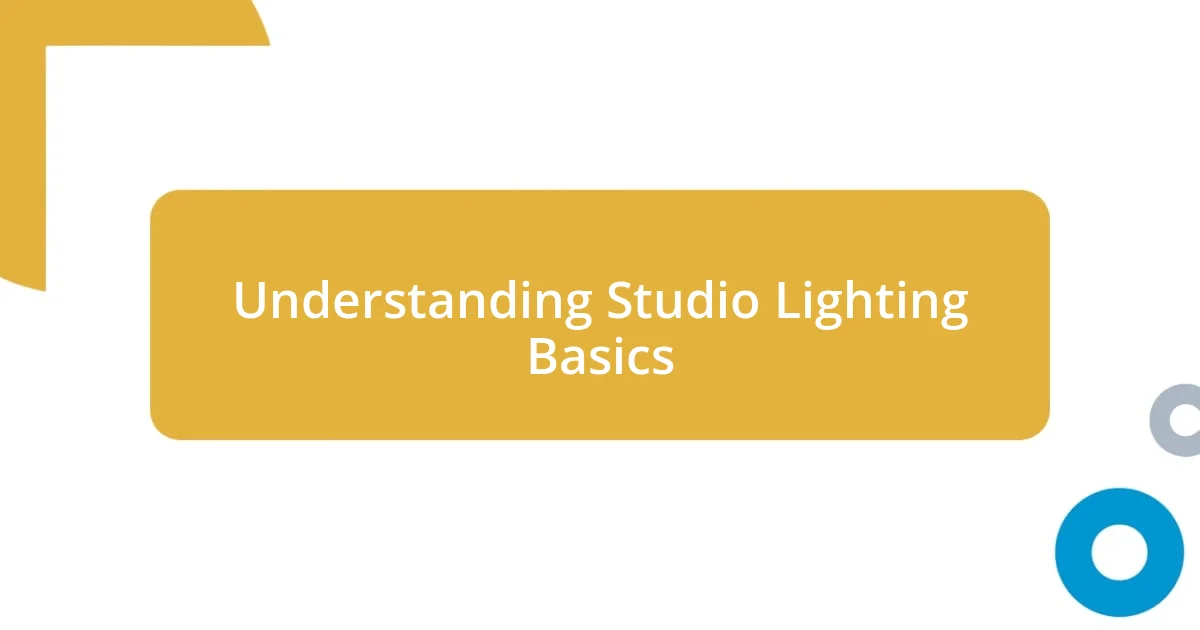
Understanding Studio Lighting Basics
When I first stepped into a studio, I was amazed by the array of lights and how they transformed a simple space into a vibrant canvas. Each type of light—be it softboxes, strobes, or LED panels—has its unique purpose and character. Have you ever wondered how a mere flick of a switch can drastically change the mood of an image? It’s all about understanding light’s quality, direction, and color temperature.
One of the biggest revelations for me was learning about the difference between hard and soft light. While hard light creates sharp shadows and highlights, often giving a dramatic effect, soft light wraps around subjects, producing a gentle, flattering glow. I remember experimenting with a softbox for the first time and being mesmerized by how it beautifully highlighted my subject’s features while eliminating harsh shadows. It felt like magic, and I can’t stress enough how vital it is to grasp these differences for impactful photography.
I also realized that positioning the lights is key in achieving the desired look. The angle, height, and distance of each light source can dramatically affect the final shot. For instance, placing a light too close can wash out your subject, while too far can lead to dull images. I often find myself adjusting the setup on a whim, discovering unique outcomes with just slight tweaks. So, what lighting setup have you experimented with? You’ll be surprised at how a simple adjustment can lead to a completely new mood in your photos.
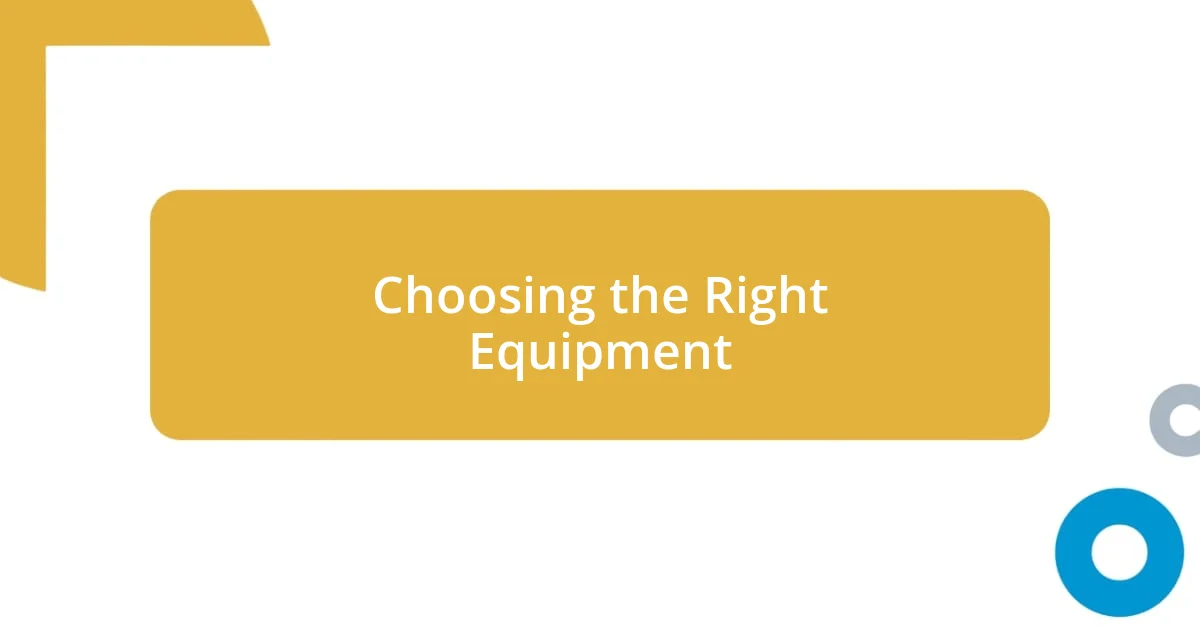
Choosing the Right Equipment
When it comes to choosing the right equipment, I’ve learned that familiarity with your options can make a world of difference. Diving deep into the variety available, I found that understanding the characteristics of different lights was crucial. I remember my first shoot where I tried using a mix of continuous lights and strobes—the contrast in results was eye-opening. Continuous lights allowed me to see how shadows played out in real time, while strobes became my go-to for those crisp, high-speed moments.
Here’s a breakdown of essential studio lighting equipment I recommend:
- Softboxes: Great for creating soft, diffused light that’s flattering for portraits.
- Strobes: Perfect for freezing motion and achieving high-intensity lighting.
- LED Panels: Versatile and portable, these offer consistent lighting and adjustable color temperatures.
- Umbrellas: Ideal for controlling light spread and producing softer shadows at a lower cost.
- Light Stands: Don’t underestimate these; having sturdy stands can make or break your setup.
The variety of equipment can seem overwhelming, but finding the right mix that resonates with your style is essential. I distinctly recall investing time to experiment and assess how different tools affected my output. It was surprisingly rewarding to uncover my preferences, and I encourage every photographer to take the leap into trying out various setups themselves.
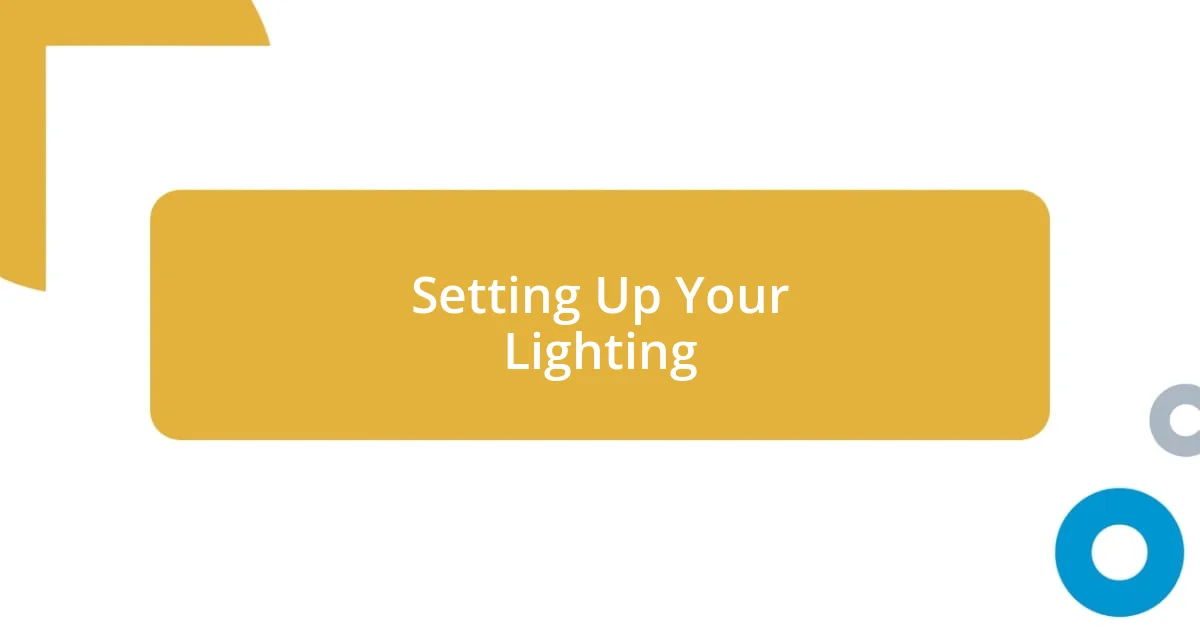
Setting Up Your Lighting
When setting up your lighting, it’s essential to start with a clear vision of what you want to achieve. I remember the first time I set up my lights for a portrait shoot; the excitement was palpable yet nerve-wracking. By figuring out the key positions for softboxes and strobes, I learned that experimenting with angles can change everything. Are you willing to play around until you find the setup that speaks to you? I know I was, and it’s how my best shots came to life.
As I dove deeper into studio lighting, I quickly discovered that the direction from which light hits your subject defines the overall mood. For instance, backlighting creates a silhouette effect, conveying a sense of mystery, while front lighting brings out details beautifully. I remember capturing a spontaneous moment of laughter, using a simple overhead softbox. The way it highlighted my friend’s joyful expression still brings a smile to my face. Lighting isn’t just technical; it’s an emotional dance that can profoundly impact the storytelling in your photography.
Don’t neglect the power of adjusting your light’s intensity, either. I recall a session where I left the strobes too bright during a shoot, and the results were glaring—definitely not the vibe I wanted. Softening the light with a diffuser or dialling down the power transformed my images instantly. It may seem like a small change, but managing how bright or soft your lights are can elevate your work dramatically. What lessons have you learned through trial and error? Sometimes, your biggest breakthroughs happen when you take control of light manipulation.
| Lighting Type | Purpose |
|---|---|
| Softboxes | Creates soft, diffused light |
| Strobes | Freezes motion and achieves high-intensity lighting |
| LED Panels | Offers consistent lighting with adjustable color temperatures |
| Umbrellas | Controls light spread and produces softer shadows |
| Light Stands | Supports and stabilizes your lighting setup |
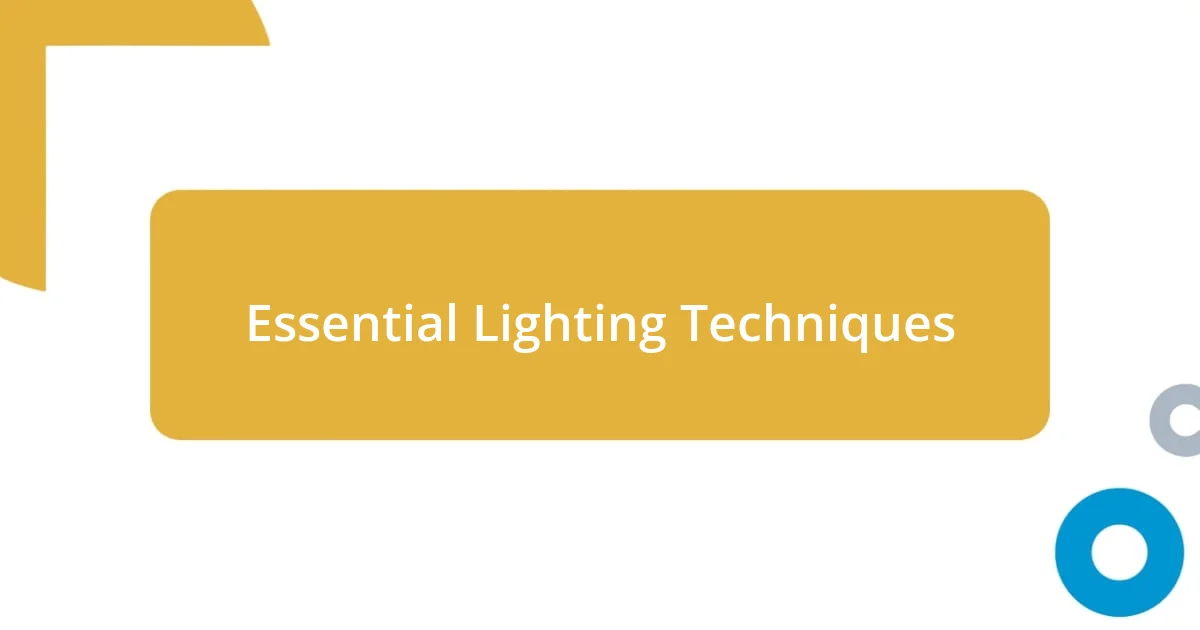
Essential Lighting Techniques
Lighting techniques are a fascinating journey in photography. One essential technique I’ve discovered is the use of three-point lighting, which consists of the key light, fill light, and backlight. When I first tried this method, it felt like a revelation. The key light defined my subject, while the fill light softened shadows and the backlight added depth. That seamless triangle created an enchanting look that transformed my portraits completely. Have you ever noticed how the right triangle of lights can bring a flat image to life? I certainly have, and it’s something I now use as a fundamental approach.
Another technique that completely changed my perspective is the high key versus low key lighting approach. I remember experimenting with high key lighting for a joyful, bright shoot, and the results were simply exhilarating—the atmosphere felt light and airy, evoking happiness. Conversely, when I ventured into low key lighting, it was as if I uncovered a whole new world of emotion. The darker tones gave my subject an aura of mystery and depth, perfect for telling complex stories. These techniques pushed me to think about not just how I lit but why I chose certain styles for specific emotions.
Lastly, let’s not overlook the importance of practical lighting. I vividly recall one session where I used a lamp and some fairy lights in the background. The warm glow added an authentic touch, enhancing the atmosphere effortlessly. It’s moments like these that truly resonate with the viewer—not just through the light but through the story it tells. Have you thought about how incorporating real-world light sources could elevate your work? I know my experimentation with practical lighting has made my images more relatable and evocative, something every photographer should explore.
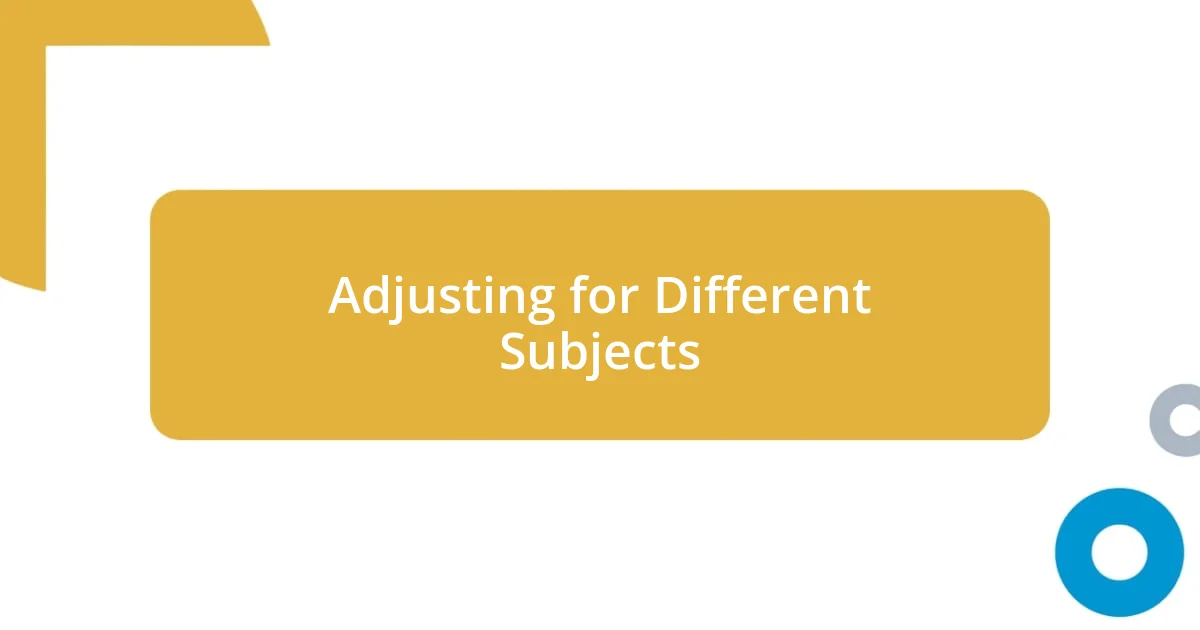
Adjusting for Different Subjects
Adjusting your lighting for different subjects is crucial for capturing their essence. I remember a time when I photographed a model with striking features. I quickly realized that a hard light source created harsh shadows, which didn’t complement her delicate bone structure. By switching to a softbox and positioning it slightly above and to the side, I was able to create a gentle glow that emphasized her beauty instead of overshadowing it. That simple adjustment transformed the entire dynamic of the shoot.
Different subjects often require tailored lighting techniques. For instance, when shooting products, I learned that even slight variations in light direction could affect how textures were perceived. I once shot a glass vase and initially lit it from the front; it appeared flat and lifeless. By repositioning the light at a 45-degree angle, the reflections danced beautifully across the surface, bringing out the intricate details. Have you ever noticed how some subjects just come alive under the right light? It’s fascinating to see how lighting can unlock a subject’s hidden potential.
When working with multiple subjects, adjusting the light for each one can be a delightful challenge. During a group shoot, I found that my softbox provided even lighting for everyone, but the shadows fell awkwardly across one friend’s face. I introduced a reflector to bounce light back onto her, creating harmony in the composition. It’s those moments of creativity that remind me of the beauty in collaboration. Isn’t it rewarding when you can create a well-lit image that makes every subject shine?
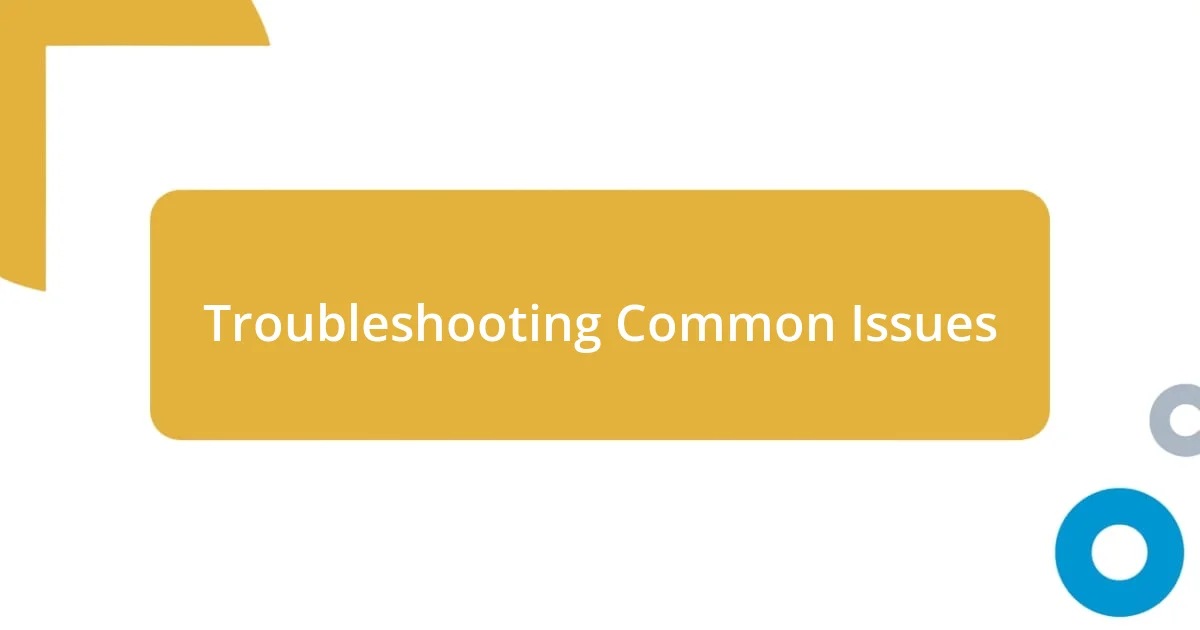
Troubleshooting Common Issues
When working with studio lighting, it’s inevitable to face a few hiccups. I recall a day when my key light unexpectedly burnt out mid-shoot. Panic nearly set in, but I remembered my backup equipment tucked away in the corner. Switching to a different light source not only saved the session but taught me to always have a plan B ready. Have you ever faced a sudden equipment failure? It’s a testing moment that can turn into a valuable lesson.
Another common issue I often encounter involves unwanted shadows creeping into the frame. I vividly remember a shoot where reflections danced erratically on my subject’s face, making it look less appealing. To counteract this, I adjusted the light angle and used a diffusing cloth to soften the beam. The difference was remarkable. Shadows went from being distractions to subtle enhancements. Have you noticed how tweaking your setup just a little can make such a big difference?
Lastly, color temperature can become a tricky beast when mixing lights. During one particular shoot, I used my softbox paired with an overhead LED lamp, unaware of the clash in color temperatures. The result? A bizarre mix of warm and cool tones that made my subject look sickly. After some research and a quick adjustment of the softbox to match the LED’s hue, the scene transformed into a more cohesive palette. Have you ever struggled with color mismatches? Understanding this aspect has greatly improved my lighting skills and overall aesthetics in photography.
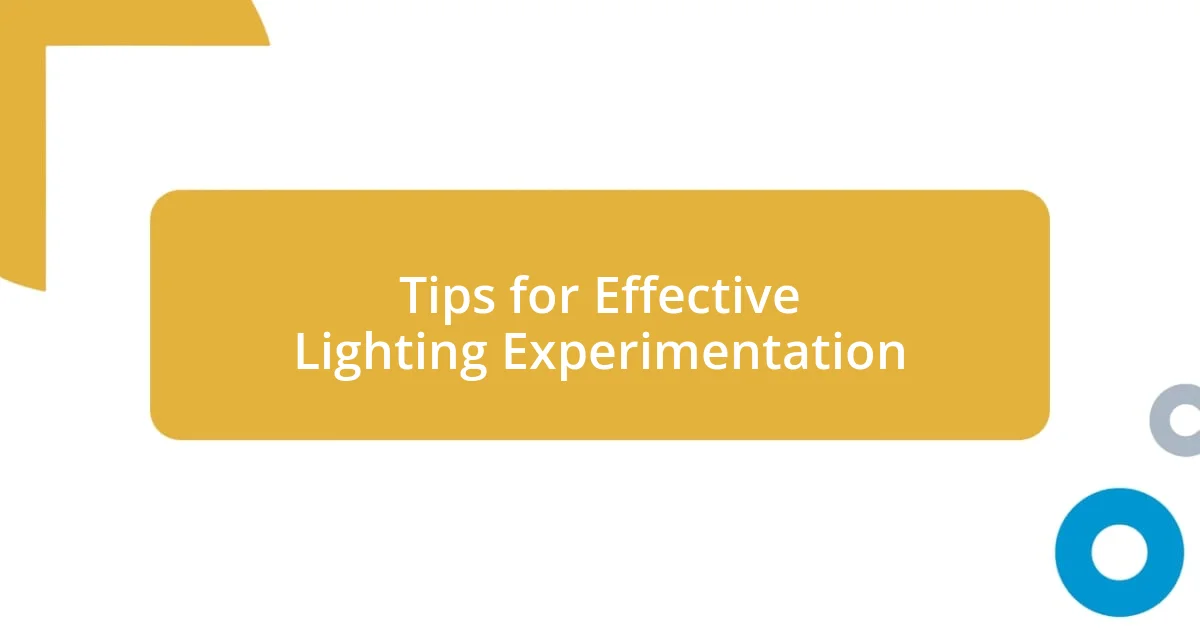
Tips for Effective Lighting Experimentation
Experimenting with lighting can sometimes feel like a dance, and finding the rhythm is key. I remember a shoot where I decided to play with different light modifiers. I had a bare bulb and an umbrella softbox available, so I switched between them. The bare bulb gave a raw, edgy look, while the umbrella softened the shadows significantly. Each mood produced an entirely different ambiance. Have you tried contrasting lighting styles? You might discover a transformative effect.
Another effective strategy is to work with your environment. One memorable session took place in a rustic barn, where the natural light filtering through the slats created beautiful patterns. By adding a little bounce from a white board, I enhanced those beams without losing that cozy, natural feel. It’s surprising how much you can leverage existing light to elevate your creative vision. Have you ever played with natural light sources in your projects? Mixing them can lead to stunning, unexpected results.
Don’t underestimate the power of adjusting the distance between your light source and your subject. I recall a time I was photographing a musician on stage. Initially, I had the spotlights too far away, making the image look washed out. Once I brought the lights closer, their presence was felt, and the energy of the performance leaped off the frame. Isn’t it amazing how proximity can create connection? Sometimes, just moving a few feet can turn a good shot into a great one.












